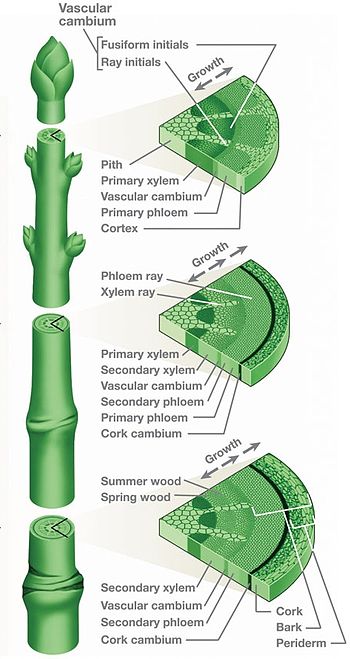- Cork cambium
-
Cork cambium (pl. cambia or cambiums) is a tissue found in many vascular plants as part of the periderm. The cork cambium is a lateral meristem and is responsible for secondary growth that replaces the epidermis in roots and stems. It is found in woody and many herbaceous dicots, gymnosperms and some monocots, which usually lack secondary growth.
Cork cambium is one of the plant's meristems - the series of tissues consisting of embryonic (incompletely differentiated) cells from which the plant grows. It is one of the many layers of bark, between the cork and primary phloem. The function of cork cambium is to produce the cork, a tough protective material.
Synonyms for cork cambium are bark cambium, pericambium or phellogen. Phellogen is defined as the meristematic cell layer responsible for the development of the periderm. Cells that grow inwards from the phellogen are termed phelloderm, and cells that develops outwards are termed phellem or cork (note similarity with vascular cambium). The periderm thus consists of three different layers:
- phelloderm - inside of cork cambium, composed of living parenchyma cells
- phellogen (cork cambium) - meristem that gives rise to periderm
- phellem (cork) - at maturity, dead, air-filled protective tissue on the outside
Growth and development of cork cambium is very variable between different species, and also highly dependent on age, growth conditions etc. as can be observed from the different surfaces of bark; smooth, fissured, tesselated, scaly, flaking off, etc.
Economic importance
- Commercial cork is derived from the bark of the cork oak (Quercus suber). Cork has many uses including wine bottle stoppers, bulletin boards, coasters, hot pads to protect tables from hot pans, insulation, sealing for lids, flooring, gaskets for engines, fishing bobbers, handles for fishing rods and tennis rackets, etc. It is also a high strength-to-weight/cost ablative material for aerodynamic prototypes in wind tunnels, as well as satellite launch vehicle payload fairings, reentry surfaces, and compression joints in thrust-vectored solid rocket motor nozzles.
- Many types of bark are used as mulch.
See also
- Bark
- Meristem
- Cork (material)
- Vascular cambium
- Sun scald (flora)
- Frost crack
References
- Junikka, L. (1994) Macroscopic bark terminology. IAWA Journal 15(1): 3-45
- Trockenbrodt, M. (1990) Survey and discussion of the terminology used in bark anatomy. IAWA Bulletin, New Series 11: 141-166.

This botany article is a stub. You can help Wikipedia by expanding it.

